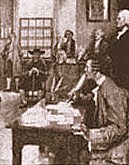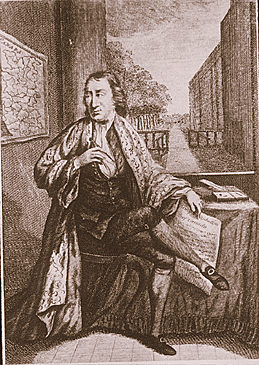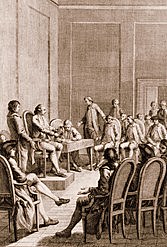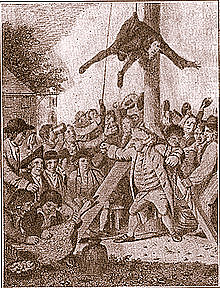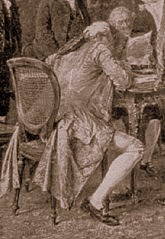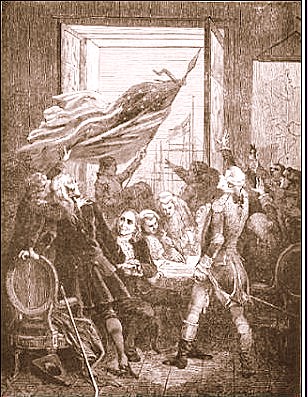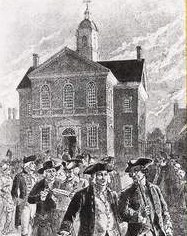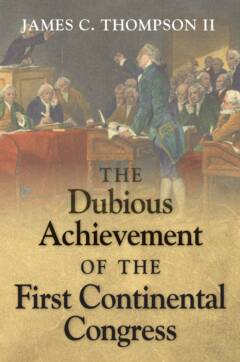The Dubious Achievement of the 1st Continental Congress is the biography of a document.
What is known today as the “Declaration of Rights and Grievances” was created by John Adams as he corrected the record of the Congress between the 22nd and the 26th of October 1774. Adams constructed this document from committee reports that had been prepared and submitted to the Congress separately.
Having assembled this new “declaration”, Adams passed it with the rest of his revisions to his friend and political ally, Charles Thomson. Secretary of the Congress Thomson then incorporated it into the congressional record. This was done after the Congress adjourned - and after its members had departed from Philadelphia. The dubious achievement of the 1st Continental Congress is the official recognition of a document that the Congress neither approved nor even considered.
The Congress did consider (and approve) a report on the grievances of the colonies prepared and submitted by the sub-committee it had appointed to do this. This sub-committee was chaired by General John Sullivan. At the time the Congress established this first sub-committee, it also created a second sub-committee, this one to draft a report on the rights of the colonies. John Adams was appointed chairman of this panel. Adams proceeded to draft its report himself. The members of Adams’s sub-committee approved his “bill of rights”, but it met with insurmountable opposition in the “great committee” which had commissioned the report.
Adams twice re-drafted the report, but the Great Committee was dissolved before voting on Adams’s final revision. Because the report was never released by this committee, the general Congress never considered it.
The Dubious Accomplishment of the 1st Continental Congress explains why Samuel Adams and his cousin John—leaders of the patriotic faction— considered a “bill of rights” essential to their cause, why the conservative faction objected to it, how these “Tories” prevented the Congress from concluding on the matter, how Adams and Thomson manipulated their unsuspecting colleague (John Dickinson) to get Adams’s phantom declaration into the record of the Congress and how by doing so they prepared the way for their forthcoming demand for political independence.
The story is told in these four illustrated parts:
Part I: Agents of Empire and Rebellion, 1754—1767
The story’s introductory segment recounts how the imperialist policies of William Pitt set England on its road to empire, how the burdensome financial obligations that attended its acquisition of France’s North American territories created political problems in England and how the leaders of the English Parliament transported this turmoil to Britain’s American colonies with their unprecedented new revenue policies. The men who superintended England’s emerging empire and the American “patriots” who organized and managed the forthcoming rebellion against it are introduced in this segment. It concludes by remembering that the colonials forced Parliament to rescind the Sugar Act and the Stamp Act and that Parliament therefore redoubled its efforts to collect the duties prescribed in the Townshend Act of 1767.
Part II:  The Patriotic Movement, 1767 - 1774
The Patriotic Movement, 1767 - 1774
The story’s second segment recounts the steady deterioration in relations
between Britain’s tax collectors and their military guards and the people of Boston. It observes how a cell of patriotic activists began to organize resistance to Parliament’s revenue policy and that the focus of this resistance gradually shifted from Parliament’s objectionable policies to Britain’s “over-subordinate” government. It traces the sequence of events that produced the “Boston Massacre”, the “Gaspee Affair” and the “Boston Tea Party”. It recounts that Lord North closed the Port of Boston in response to this last insulting act of vandalism and it observes that Boston’s patriots responded to this punitive measure by transforming their “patriotic” movement into an “independence” movement. This segment concludes by remembering that Samuel Adams, leader of Boston’s patriots, undertook to unite the colonies in common cause after the closing of the Port of Boston and that conservatives in Massachusetts’s sister colonies, hoping to avoid the untoward consequences of such a move, proposed a “congress of the colonies” to consider the matter.
Part III: Congressional Politics, 5 October 1774 - 26 October 1774
The story’s third segment observes that while the call for the “congress of the colonies” did not originate with Massachusetts‘s patriotic leaders, they recognized it as an opportunity and joined it with a two-part plan to advance their new political agenda. It remembers that the first part of this plan, to be superintended by Sam Adams, was to rally support for the “solemn league and covenant” that Adams had called for in June. The second part of this plan, to be superintended by his cousin John, was to approval for a bill of rights that would define the conflict between British America and England in terms that supported the new patriotic objective. It remembers that Samuel Adams quickly accomplished his mission and that just as quickly his cousin John ran into a hornet’s nest of opposition. It explains that John wanted to replace the original patriotic “argument from right”, which claimed that Parliament was infringing rights guaranteed to the colonials under England’s unwritten Constitution, with the more-sweeping claim that Britain’s government, tyrannical by its nature, violated the “inherent and inalienable" rights of man. It explains that among the rights embedded in the patriotic interpretation of Natural Law was the so-called “right to revolution” and that the Adams cousins considered it essential for the Congress to approve a bill of rights with a Natural Law claim because this was the theoretical justification for breaking with England. This segment concludes by remembering that loyalists in the Congress, perceiving the patriotic purpose, fiercely resisted Adams’s plan to recognize Natural Law as a co-equal source of colonial rights.
Part IV: The Great Political Hoax, October 14 - October 27 1774
The final segment of the story begins by remembering Joseph Galloway of Philadelphia, leader of the loyalist faction in the Congress and that Galloway viewed Samuel Adams’s faction as “the violent party” and Adams’s patriotic program as “a complete declaration of war against Great Britain”. It observes that Galloway and hisfollowers vehemently objected to giving Natural Law equal standing with English Common Law because, while the Common Law had proved itself over centuries of use in protecting individual liberty, Natural Law was little more a vague, malleable political theory. More to the point, loyalists like Galloway objected to a political logic that would justify a potentially disastrous policy of rebellion. Galloway therefore committed himself to prevent recognition of this “enlightened” principle. The book explains that Adams was unable to overcome Galloway’s resistance and that, with help from his unsuspecting colleague (John Dickinson) and from his political ally (Charles Thomson), he instead maneuvered around it. It observes that their manipulation of the congressional record allowed the “violent party” to avoid a political defeat. It concludes by observing that the significance of Adams’s and Thomson’s political hoax diminished six months later when a company of embattled farmers fired “the shot heard round the world” at the Old North Bridge in Concord, Massachusetts.
Endnote
Thomas Jefferson completed the transformation of the moral concept framed by Thomas Hobbes in 1651 and invoked by John Locke three decades later. In the preamble of his Declaration of Independence, Jefferson unveiled the revolutionary political instrument that justified going to war to achieve American independence. Their importance to the cause of liberty notwithstanding, natural law and natural right did not survive long as living concepts in America’s political cosmology. They were effectively decommissioned on 15 December 1791, when three fourths of the now-united states incorporated a “bill of rights” into their Constitution. With this enlightened correction of the original charter, “positive law” and “civil right” superseded the unstable, politically dangerous concepts Jefferson invoked to justify the rebellion of the American colonies. It has taken two hundred years of manipulation by selfserving political factions to wear the gears off this new machinery.
Index of Topics and Illustrations
Acts
Coercive Acts of 1774
 THE MASSACHUSETTS GOVERNMENT ACT
THE MASSACHUSETTS GOVERNMENT ACT
 THE ADMINISTRATION OF JUSTICE ACT
THE ADMINISTRATION OF JUSTICE ACT
 THE QUARTERING ACT
THE QUARTERING ACT
 THE QUEBEC ACT
THE QUEBEC ACT
Declaratory Act of 1766
Mutiny Act of 1765
New York Restraining Act of 1767
Stamp Act of 1765
Sugar Act of 1764
Townshend Acts of 1767
The Commissioners of Customs Act
The New York Restraining Act (also referred to as the Suspending Act)
The Revenue Act
The Vice Admiralty Court Act
Townsend’s Duties
Documents:
A Candid Examination of the Mutual Claims of Great Britain and the Colonies: with a Plan of Accommodation on Constitutional Principles (Joseph Galloway, 1775)
A Summary View of the Rights of British America (Thomas Jefferson, 1774)
An Inquiry into the Rights of the British Colonies (Richard Bland, 1766)
Considerations on the Authority of Parliament (James Wilson, 1774)
Considerations on the Propriety of Imposing Taxes in the British Colonies, for the purpose of Raising Revenue by Act of Parliament (Daniel Dulany, 1765)
Declaration of Independence (Thomas Jefferson, 1776)
Declaration of Right of 1689 (Parliament)
Declaration of Rights and Grievances (John Adams, 1774)
Fairfax Resolves (George Mason, 1774)
Letters from a Farmer (John Dickinson (2 December 1767–15 February 1768)
Leviathan (Thomas Hobbes, 1651)
The Life of Patrick Henry (William Wirt, 1817)
Natural Rights of the Colonists as Men (Samuel Adams, 1772)
Second Treatise of Government (John Locke, 1688)
Suffolk Resolves (Joseph Warren, 1774)
The Influence of America (Lord Acton, 1861)
The Junius Letters (Sir Philip Francis, 1769)
The Rights of the British Colonies Asserted and Proved (James Otis, 1764)
The Rights of the Colonies Examined (Stephen Hopkins, 1765)
Virginia Declaration of Rights (George Mason, 1776)
Whether it be Lawful to Resist the Supreme Magistrate, if the Commonwealth Cannot be Otherwise Preserved (Samuel Adams, 1743)
Other Topics and Illustrations
A Committee Deliberates in the Continental Congress (Illustration)
A Revolution of Natural Law against the Common Law
Adams, John (1736–1826)
 (Illustrations)
(Illustrations)
Adams, Samuel (1722–1803)
 (Illustrations)
(Illustrations)
Annus Mirabilis (Illustration)
Argument from Sovereignty
Battle of the Monongahela (9 July 1755)
Bill of Rights
Bland, Richard (1710–1776)
 (Illustration)
(Illustration)
Boston Massacre
 (Illustration)
(Illustration)
Boston Tea Party
 (Illustrations)
(Illustrations)
Braddock, (General) Edward
 (Illustration)
(Illustration)
Britannia (Illustration)
(British) Empire
British ‘Lobsterbacks’ Maintain Civil Order in Boston (Illustration)
Burgesses Meeting in the Raleigh Tavern (Illustration)
Call to Arms (Illustration)
Carpenters’ Hall, Philadelphia (Illustration)
Carter, Landon (710-1778)
Castle William in Boston Harbor (Illustration)
Charles II
_In his Coronation Robes (Illustration)
Circular Letter of June 1774
Civil Disorder in Boston
Committee(s) of Correspondence
Committee of Fifty One
Common Law (English)
 (Illustration)
(Illustration)
Concord Hymn, “The shot heard round the world”
Congress Adjourns from Carpenters’ Hall (Illustration)
Congressional Politics, 5 September 1774—26 October 1774
Creating the Framework for a Political Change
Cushing, Thomas (1725–1788)
 (Illustration)
(Illustration)
The Dartmouth (English Merchant Ship)
Dickinson's Draft
 Why Thomson matched the two declarations
Why Thomson matched the two declarations
Dickinson, John (1732–1808)
 The Dickinson Factor
The Dickinson Factor
 (Illustrations)
(Illustrations)
Dulany, Daniel, (1722–1797)
 (Illustration)
(Illustration)
England’s Unwritten Constitution
Enlightened Natural Law and Natural Right
Facsimile Illustration of Delegates in the 1st Congress (Illustration)
First Continental Congress
 (Illustration)
(Illustration)
 Prepping for the Philadelphia Congress
Prepping for the Philadelphia Congress
 Congressional Declarations (Illustration)
Congressional Declarations (Illustration)
First Virginia Convention (May 1774)
FitzRoy Augustus Henry, 3rd Duke of Grafton (1735–1811)
 (Illustration)
(Illustration)
Franklin, Benjamin (1706-1790)
Gage, (General) Thomas
 and Martial Law
and Martial Law
 (Illustration)
(Illustration)
Galloway, Joseph (1731–1803)
 (Illustration)
(Illustration)
Grenville, George, (1712–1770)
 (Illustration)
(Illustration)
God Gives the Law to Moses (Illustration)
Hancock, John (1737-1793)
Henry, Patrick (1736–1799)
 (Illustrations)
(Illustrations)
Hill, Wills, Lord Hillsborough (1718-1793)
HMS Romney in Boston Harbor (Illustration)
Hobbs, Thomas (1588-1679)
 [Illustration)
[Illustration)
Hopkins, Stephen (1707–1785)
 (Illustration)
(Illustration)
House of Commons (Illustration)
How Locke’s Moral Concept Became a Post-Enlightened Political Principle
Hutchinson, Thomas (1711–1780)
 (Illustration)
(Illustration)
It Was Unlike Thomson to Ignore Favorable Developments (Illustration)
Jefferson, Thomas (1743-1826)
 (Illustration)
(Illustration)
John Adams Acknowledged that He Did Not Win This Debate
John Dickinson Sounds the Alarm
Journal of the Continental Congress
King George II (1683-1760)
King George III (1738-1820)
King John Signing Magna Carta at Runnymede (1215) (Illustration)
Lee, Richard Henry (1732-1794)
Living Together in Pursuit of a ‘Common Good' (Illustration)
Locke, John (1632-1704)
 (Illustration)
(Illustration)
Locke’s View of the Patriotic Right to Revolution
Loyalist Opposition
Manipulating John Dickinson
Mason, George, (1725–1792)
 (Illustrations)
(Illustrations)
Minutemen at Concord Bridge (Illustration)
Moral Law
Natural Law and Natural Right
News from America, or the Patriots in the Dumps (Illustration)
North, Frederick, 2nd Earl of Guilford (1732–1792)
 (Illustrations)
(Illustrations)
Otis, James (1725–1783)
 (Illustrations)
(Illustrations)
Patriotic Argument from Right
Patriotic Movement
Patriotic End Game
 Patriotic Movement Spreads to Virginia
Patriotic Movement Spreads to Virginia
Patriotic Right to Abolish Tyrannical Government
Patriots Gathered around a Liberty Tree (Illustration)
Pehlam-Holles, Thomas, Duke of New Castle (1693–1768)
 (Illustration)
(Illustration)
Penn’s First Sight of the Shores of Pennsylvania as He Ascends the River From Whence the Air Smelt as Sweet as a New-Blown Garden (Illustration)
Philadelphia: Parade of the Victuallers (Illustration)
Pitt, William, Lord Chatham (1708–1778)
 (Illustration)
(Illustration)
Political Debate (Illustration)
Port of Boston—Closing (1 June 1774)
Preston, Captain Thomas
Randolph, Peyton (1721–1775)
 (Illustration)
(Illustration)
Revere, Paul (1734-1818)
 (Illustration)
(Illustration)
Right of Resisting
Right to Revolution
Seeding the Rebellion
Shaping Public Opinion (Illustration)
Shooting General Braddock at Fort Duquesne—1755 (Illustration)
Solemn league and covenant
Stamp Act of 1765 Resolutions
Stamp Act of 1765 Riots
 (Illustration)
(Illustration)
Stamp Act Congress
Stars and Stripes (Illustration)
Stuart, John, 3rd Earl of Bute (1713–1792)
 (Illustration)
(Illustration)
Sullivan's Draft
The Beheading of Charles I—1649 (Illustration)
The British Fleet at Anchor in Boston Harbor (Illustration)
The Congress Never Concluded Debate on Adams’s Bill of Rights
The Dubious Achievement of the 1st Continental Congress
The East India Company Crisis
The East India Company Building (Illustration)
The Fight at Concord Bridge (Illustration)
The Flaw in the Boston Committee’s Plan
The French and Indian War
The Gaspee Affair
 (Illustration)
(Illustration)
The Great Committee Debates Adams’s Bill of Rights (Illustration)
The Great Political Hoax, 14 October—27 October 1774
The King’s Privy Council Debates Policy (Illustration)
The Liberty Affair
The Philadelphia debate was more contentious
The Virginians Respond
The Writs of Assistance Case of 1761
Thomson Charles (1729-1824)
 (Illustrations)
(Illustrations)
Tories Debating their Patriotic Opponents (Illustration)
Townshend, Charles (1725–1767)
 (Illustration)
(Illustration)
Union Jack (Illustration)
Walpole, Robert (1676-1745)
Warren, Joseph (1741–1775)
 (Illustrations)
(Illustrations)
Watson-Wentworth, Charles, 2nd Marquess of Rockingham (1730–1782) 

 (Illustration)
(Illustration)
Washington, George, (1732-1799)
 (Illustration)
(Illustration)
William and Mary Receive the Declaration of Right with their Crown (Illustration)
Wilson, James, (1742-1798)
 (Illustration)
(Illustration)




